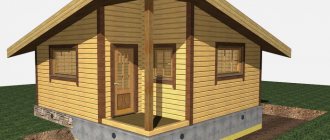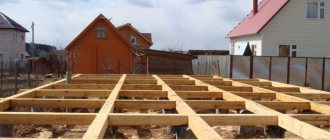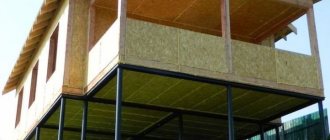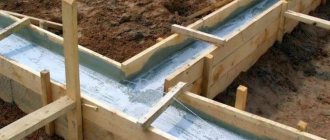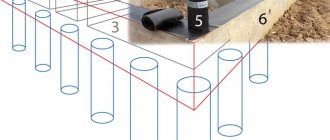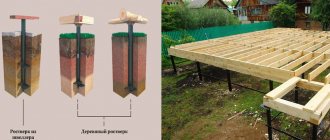The requirements for the foundation are very high.
The strength and reliability of the foundation are among the main, but not the only tasks assigned to supporting structures.
The strip foundation is capable of performing its functions in various conditions, which has been confirmed by centuries-old research.
The high popularity of the tape is due to the optimal combination of load-bearing capacity and efficiency, simplicity and durability.
The main advantage is the possibility of independent construction.
Kinds
The strip foundation is a continuous closed supporting structure located under all external and internal load-bearing walls. In fact, this is a recessed base that can withstand loads from the weight of the building, soil pressure and other influences.
There are the following types of strip foundations::
- Monolithic. It is a one-piece casting made of reinforced concrete and has maximum strength and load-bearing capacity.
- Made. The tape is built from individual fragments or elements - foundation blocks (FBS), brick, natural stone, etc. The performance qualities of this type of base are somewhat lower than those of a monolithic tape.
- Combined. It is a combination of a strip base with another type - for example, a pile-tape base. Allows you to obtain reference points on which the load-bearing belt is installed.
In addition, there are variations in depth :
- Not buried. It is created on absolutely motionless soils - rocks, strong stable soils. It is extremely rare.
- Shallow. Used for construction on durable soils not subject to frost heaving. The depth is less than the level of winter soil freezing.
- Recessed. The depth of such a tape is slightly below the soil freezing level. Used for the most massive and heavy buildings, suitable for most types of soil and hydrogeological conditions.
The choice of the appropriate type is determined by an analysis of all site conditions - soil composition, number and properties of layers, depth of soil water, etc.
Types of strip foundation
Before you make a strip foundation with your own hands, it is worth studying its design features. Depending on the technology used, the tape is of two types:
- monolithic;
- team.
a – monolithic;
b – prefabricated Monolithic strip foundation will be a more profitable option for frequent construction. Prefabricated technology is more often used for mass construction. This is due to the fact that concrete blocks and prefabricated reinforced concrete foundation slabs are used for installation. Such structures are on average 1-2 meters long and weigh from a couple of hundred kilograms to a couple of tons.
The construction of a strip foundation made of blocks becomes impossible without renting lifting equipment: a tower or truck crane. This will significantly increase the cost of construction. In addition, in a small area, the problem of placing mechanisms arises.
Pouring a strip foundation avoids additional costs. This option is rational when building a house with your own hands. A few people will be enough to complete the work.
By design, the tape is of three types:
- deep strip foundation;
- shallow;
- not buried.
The first option is suitable for the construction of buildings on any basis. In this case, it is possible to make a basement or technical underground for utilities. The construction of a shallow-type strip foundation is considered for small buildings and in the case of non-heaving soils with good strength (coarse, medium or coarse sands) occurring on the site.
The non-buried strip is used only for auxiliary buildings. You can put a gazebo or canopy on it. A properly selected type of foundation will be the key to the success of all work.
What buildings is it suitable for?
Strip foundations are a reliable support for buildings made of various materials:
- Tree.
- Foam and aerated concrete.
- Brick.
- Concrete plates.
The material and number of floors determine the weight of the building, on which the design parameters of the tape depend - the degree of depth and thickness. Along with the soil characteristics, the building parameters are the main material for performing engineering calculations during design.
Features of a do-it-yourself pile-strip foundation.
Do-it-yourself pile strip foundation step-by-step instructions.
Pile-strip foundation is one of the types of strip foundation. It consists of a continuous shallow grillage. on which the walls of the building rest during operation, and piles installed in the ground below the freezing depth (Fig. 5). This design allows not only to reduce the cost of building a foundation, but also to increase its adhesion to the ground.
Below is a step-by-step instruction for a do-it-yourself pile-strip foundation:
- Site preparation. As in the case of a strip-type reinforced concrete foundation, the construction site is cleared of debris, leveled and marked.
- Land works. A trench is dug under the tape up to 50 cm deep. The bottom of the trench is filled with gravel or sand and compacted. Then, holes for piles are drilled in the corners of the future structure, at the junctions of the walls and every 200 cm. The depth of the wells should be 30-40 cm greater than the freezing depth. The cross-section of the holes is chosen so that the piles fit into them without much effort.
- Installation of piles. Metal or asbestos-cement pipes are installed in the prepared wells, after which they are reinforced and concrete mixture is poured into them.
- Formwork design, reinforcement and concrete pouring . This stage is performed in almost the same way as for the strip base. The only difference is that the reinforcement of the piles is necessarily connected to the reinforcement of the grillage.
The operational characteristics of the entire building depend on how correctly the strip or pile-strip foundation is erected. Therefore, it is necessary to carefully prepare for the upcoming work by studying the installation technology and understanding all the nuances that you may encounter when performing the task.
Recommendation: A good large review article, from it you will learn about step-by-step instructions for a strip foundation. In reality, many moments will arise that cannot be foreseen in advance; as a result, you will make many mistakes and lose your money. To avoid making mistakes and losing money, you need to study all the technology very carefully and be sure to talk to professionals. Only after this can you think whether you can build a strip foundation with your own hands or not?
How to calculate depth
Calculation of the depth of the strip foundation depends on the type of foundation. If it is planned to build a buried version, then it is necessary to rely on the tabular data of SNiP, displaying the depth of soil freezing in a given region.
When constructing a shallow type of belt, the composition of the soil, the presence and depth of groundwater are taken into account. The optimal depth is usually considered to be 0.75-1 m, but on stable and dry soils the depth can be slightly reduced.
NOTE!
The most common immersion depth for a shallow belt is considered to be 0.7 m.
Choosing a concrete grade for the foundation
It is the grade of concrete that is the main one in determining the strength characteristics of a structure, directly affecting its load-bearing capacity. For pouring, a mixture from M100, with a strength equal to 7.5 MPa, to M700, corresponding to 50 MPa, can be used.
Direct calculation of concrete for a strip foundation is carried out according to the following criteria:
- structural load;
- moisture resistance requirements, directly determined by the depth of the foundation of the house;
- design and other features of the foundation itself.
Using the example of specific buildings for the construction of which different types of materials are used, it looks like this:
- concrete grades M100, M150 belong to the lowest class and are used as pouring concrete pads during the construction of prefabricated foundation structures;
- M200, M250 - used when pouring monolithic tape under wooden and frame buildings, as well as for installing a sole under FBS blocks;
- M300 and M350 are the most popular and popular brands, recommended for the construction of brick and stone houses with 2-3 floors, they are also suitable for the construction of buildings made of cellular types of concrete, although for them, in normal geological conditions and low groundwater levels, it is quite You can even use M250.
Concrete grades from M400 and higher are practically not used for foundation construction in private housing construction, due to their high cost, as well as the lack of obvious need for it.
Since concrete is a solution consisting of a binding component (cement), filler (gravel and sand) and water, the cost of a strip foundation largely depends on the brand of cement used in the production of the concrete mixture.
How is a shallow strip foundation constructed?
A shallow strip foundation almost completely repeats the buried version, only with a lower level of immersion.
There is a trench in which a drainage layer of backfill is created and a concrete strip is poured .
The design of a shallow foundation has fewer capabilities than a full-fledged tape, but for relatively small low-rise buildings its load-bearing capacity is quite sufficient.
Step-by-step DIY installation instructions
Let's consider the procedure for creating a strip foundation:
- Preparation.
- Site marking.
- Digging a trench.
- Laying and arrangement of the drainage system.
- Creating a sand cushion.
- Production of formwork.
- Installation of reinforcement cage.
- Pouring concrete.
- Wait for hardening.
- Stripping.
- Waterproofing and insulation tape.
- Further work.
IMPORTANT!
The order of actions does not change under almost any circumstances, since all stages are a consequence of previous operations.
How to install a strip foundation with your own hands.
The foundation determines the performance characteristics and service life of the house, so the selection and installation of the structure must be approached with great responsibility. A strip foundation is a strong and reliable foundation for buildings with heavy floors and simple architecture.
Strip foundation step by step instructions.
The strip foundation device consists of a strip that takes the load of the entire room. It does not require careful soil preparation and is suitable for liquefied, garden, forest or clay soil. Widely used in non-uniform soil.
The main advantage of a strip foundation is that it is suitable for building a house with a basement or ground floor. Laying is easier, but requires more cost and time than other types of foundation.
Basic mistakes
Most often, sedimentation of the sand cushion occurs due to poor compaction of the backfill layer. In addition, the use of unsuitable materials, especially concrete of the wrong grade, is often encountered.
Some unscrupulous suppliers deliver low-quality material to save money. Experienced experts recommend ordering heavier concrete - instead of M200, take M250 . The difference in cost and weight is small, but there is hope that the material will be more durable.
In addition, they often try to reduce the cost of money and labor by abandoning waterproofing and insulation. These procedures require some time, but, compared to the service life of the base, they are performed very quickly and cannot be neglected.
